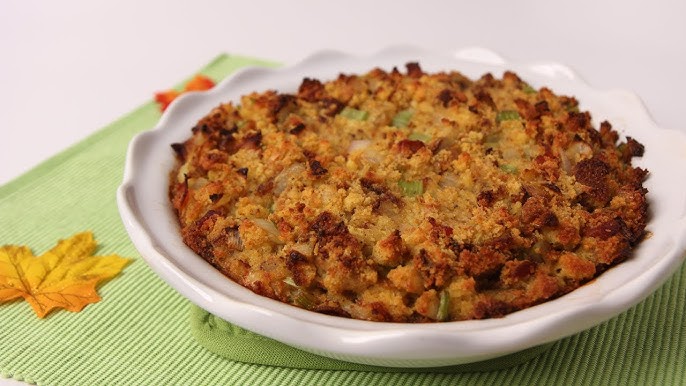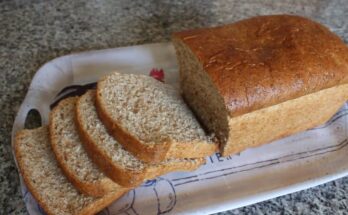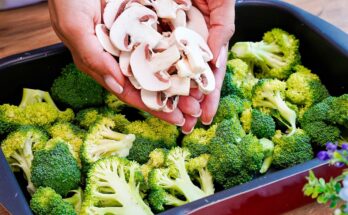Bread Dressing Recipe: There’s something heartwarming about the aroma of bread dressing wafting through the kitchen during the holidays. It’s one of those dishes that instantly feels nostalgic, reminding us of family gatherings, laughter, and the warmth of home-cooked meals. But let’s clear up a little confusion first: what exactly is bread dressing, and how is it different from stuffing?
Bread dressing is a savory side dish made with cubed bread, broth, vegetables, herbs, and seasonings, baked in a casserole dish. Stuffing, on the other hand, traditionally goes inside the turkey or chicken before baking. While both dishes share nearly identical ingredients, the preparation method sets them apart. Dressing is often lighter, crispier on the top, and easier to prepare ahead of time since you don’t have to worry about the bird.
In many households across the U.S., the word “dressing” is more common in the South, while “stuffing” tends to dominate Northern kitchens. Regardless of the name, one thing is certain—this dish is the ultimate comfort food. Whether you’re serving it for Thanksgiving, Christmas, or a simple Sunday dinner, bread dressing is versatile, flavorful, and a guaranteed crowd-pleaser.
The beauty of bread dressing lies in its adaptability. You can make it vegetarian, pack it with sausage, add dried fruit for a sweet twist, or keep it classic with simple herbs and butter. If you’ve never made it before, don’t worry—this guide will walk you through every step, from choosing the right bread to serving it fresh out of the oven. By the end, you’ll be confident enough to make this dish a centerpiece of your holiday table.
Ingredients You’ll Need
When it comes to bread dressing, the ingredients are simple, but each one plays an important role in creating that comforting, savory flavor. Think of them as the building blocks that make the dish so special.
Main Ingredients for Bread Dressing
- Bread cubes (10–12 cups): The foundation of the dish. Day-old or lightly toasted bread works best.
- Butter (1 cup): Adds richness and depth of flavor.
- Onions (2 medium, chopped): For sweetness and aromatic flavor.
- Celery (4 stalks, chopped): Adds crunch and freshness.
- Chicken or vegetable broth (4–5 cups): Brings moisture and binds everything together.
- Eggs (2, beaten): Help hold the dressing together and create a custard-like texture.
- Fresh herbs (parsley, sage, thyme, rosemary): Bring earthiness and holiday flair.
- Salt and pepper: Essential seasonings to balance flavors.
Optional Add-Ins for Extra Flavor
Want to make your bread dressing stand out? Try adding:
- Cooked sausage or bacon for a hearty, savory boost.
- Mushrooms for an earthy, umami-rich twist.
- Dried cranberries or apples for a sweet-tart balance.
- Pecans or walnuts for added crunch.
Choosing the Right Bread
The bread you use can completely change the outcome of your dressing. A sturdy loaf like French bread, sourdough, or even cornbread works beautifully. Avoid overly soft sandwich bread since it can turn mushy. The trick is to let the bread dry out a bit, either by leaving it uncovered overnight or toasting it in the oven. This way, it will soak up the broth and seasonings without collapsing into a soggy mess.
The key is balance: the bread should be dry enough to absorb the broth but still retain its structure once baked. A mix of different breads—say, cornbread and sourdough—can add complexity to the flavor and texture.
Tools and Equipment Required
Even the most flavorful ingredients won’t reach their potential without the right tools. Luckily, making bread dressing doesn’t require anything fancy—just a few kitchen basics.
Kitchen Tools You’ll Need
- A sharp knife and cutting board for chopping vegetables.
- A large skillet or sauté pan for cooking onions, celery, and any additional ingredients.
- A mixing bowl big enough to hold all your bread cubes and ingredients.
- A wooden spoon or spatula for mixing without crushing the bread.
Baking Dish Selection Tips
Choosing the right baking dish is more important than you might think. A 9×13-inch casserole dish is the standard for most recipes, but you can adjust depending on the quantity you’re making. A shallower dish will give you a crispier top layer, while a deeper one will make the interior softer and more custard-like.
If you’re hosting a large gathering, consider doubling the recipe and using two dishes instead of cramming everything into one. This ensures even baking and prevents the center from being undercooked.
Pro tip: Grease your baking dish with butter before adding the dressing. It not only prevents sticking but also adds extra richness to the edges.
Step-by-Step Guide to Making Bread Dressing
Now comes the fun part—bringing everything together. Making bread dressing is less about strict rules and more about layering flavors and textures. Follow these steps, and you’ll end up with a golden, fragrant dish that’s ready to impress.
Step 1: Preparing the Bread Cubes
The bread is the star, so treat it right. Start by cutting your loaf into 1-inch cubes. Spread them out on a baking sheet and let them dry overnight, or bake them at 300°F for 20–30 minutes until lightly crisp. The goal isn’t to brown the bread but to remove moisture, so it can soak up the broth later.
Step 2: Sautéing Vegetables for Flavor
Melt butter in a skillet over medium heat. Add onions and celery, cooking until soft and translucent, about 8–10 minutes. This step builds the base flavor of your dressing. If you’re adding mushrooms, sausage, or bacon, cook them now too. The aroma at this stage will already make your kitchen smell like the holidays.
Step 3: Mixing the Dressing Base
Once your bread cubes are dried and vegetables are softened, it’s time to combine everything into one flavorful mixture. Place the bread cubes in a large mixing bowl, then add the sautéed onions, celery, and any other cooked add-ins like sausage or mushrooms. Gently toss them together so the bread absorbs some of that buttery, savory goodness.
Next, sprinkle in your chopped fresh herbs—sage, parsley, rosemary, and thyme are classics. Dried herbs will work if fresh isn’t available, but fresh really brings out that holiday aroma. At this point, your kitchen will smell like pure comfort food. Season with salt and pepper, but don’t go overboard just yet—you’ll adjust later once the broth is added.
In a separate bowl, lightly beat the eggs and then pour them over the bread mixture. The eggs act as a binder, giving the dressing structure while keeping it soft inside. Gently fold everything together, making sure the bread stays intact. You don’t want to mash the cubes into mush—you’re aiming for a mixture that’s well-coated but still airy.
Think of this step as building the foundation. Get this balance right, and you’ll end up with a dressing that’s fluffy inside, crisp on top, and full of layers of flavor.
Step 4: Adding Broth and Seasonings
This step is where your bread dressing really comes alive. Slowly pour warm chicken or vegetable broth over the bread mixture, one cup at a time. Stir gently after each addition to let the bread soak up the liquid. Depending on how dry your bread is and how moist you like your dressing, you’ll need between 4 to 5 cups of broth.
Here’s the trick: the mixture should be moist but not soupy. If you can press the bread with a spoon and see liquid pooling at the bottom, you’ve added too much. On the other hand, if the bread looks too dry, add another splash of broth. Remember, the dressing will dry out a bit as it bakes, so a slightly wetter mixture is better than one that’s too dry.
Taste your mixture before baking. This is your last chance to adjust the seasonings. Add more salt, pepper, or even an extra pinch of herbs if needed. Some cooks like to add a dash of poultry seasoning or nutmeg for extra depth. Trust your taste buds—after all, you’re the chef here.
Step 5: Baking the Dressing to Perfection
Now for the final transformation. Preheat your oven to 350°F (175°C). Grease your casserole dish with butter, then transfer the dressing mixture into it, spreading it evenly. Don’t pack it down too tightly—air pockets help keep it light and fluffy.
Cover the dish with foil and bake for 30 minutes. This allows the inside to set without drying out. Then, remove the foil and continue baking for another 20–30 minutes, or until the top is golden brown and slightly crispy. The edges should be caramelized, while the inside stays soft and moist.
If you like your dressing extra crispy, leave it uncovered for the last 40 minutes of baking. If you prefer it softer, cover it for most of the time and uncover only for the last 10 minutes. When you pull it out of the oven, let it rest for about 10 minutes before serving—this helps the flavors meld and the structure set.
And there you have it—homemade bread dressing that’s golden, fragrant, and ready to steal the spotlight at your dinner table.
Tips for the Perfect Bread Dressing
Getting bread dressing right is all about balance—moist but not soggy, flavorful but not overpowering. Here are some tried-and-true tips to help you master it every time:
How to Keep Dressing Moist but Not Soggy
The key lies in the bread-to-broth ratio. Always start with less liquid than you think you’ll need, then add more gradually. Remember, dry bread absorbs more, while fresher bread needs less. If you accidentally add too much broth, toss in a handful of extra bread cubes to soak it up.
Another tip? Cover the dressing during the first half of baking. This locks in moisture. Uncover later to crisp up the top. This two-step method gives you the best of both worlds—tender inside, crunchy outside.
Adjusting Seasonings to Taste
Herbs and spices make or break bread dressing. Always taste the mixture before baking and adjust. If it tastes bland, add more herbs or even a splash of melted butter. A little poultry seasoning can bring all the flavors together, while a dash of nutmeg or allspice adds warmth.
For families with different preferences, you can divide the mixture into two smaller baking dishes—make one with sausage and bolder seasonings, and another lighter and vegetarian. That way, everyone’s happy at the table.
Variations of Bread Dressing
One of the best things about bread dressing is its versatility. The classic version is always a hit, but you can easily adapt the recipe to suit your tastes, traditions, or dietary needs. Let’s explore some delicious variations that can transform this comforting dish into something uniquely yours.
Classic Southern Cornbread Dressing
In the South, cornbread is the star. This variation swaps out traditional bread cubes for crumbled cornbread, giving the dish a slightly sweet flavor and crumbly texture. Cornbread dressing often includes sage, onions, celery, and plenty of butter, but it can also feature hard-boiled eggs for extra richness. The result is a deeply flavorful, hearty side dish that pairs beautifully with roast turkey or ham.
To make it, simply replace half (or all) of the bread cubes with cornbread. Be sure the cornbread is slightly dry so it doesn’t turn mushy when mixed with broth. The flavor difference is noticeable—cornbread adds a rustic, homey taste that many people swear by during Thanksgiving.
Herb and Sausage Bread Dressing
If you want a heartier dish, sausage is the way to go. Brown some crumbled sausage in a skillet and add it to your bread dressing mixture. The fat from the sausage adds depth, while herbs like sage and thyme complement its flavor. Some cooks even like to add fennel seeds for a little extra punch.
This variation is ideal for meat lovers and makes the dressing feel like a meal on its own. It’s especially delicious when paired with roasted poultry or pork. For an even richer version, use a mix of sausage and bacon—you’ll get layers of smoky, savory goodness in every bite.
Vegetarian Bread Dressing
Don’t worry—vegetarians don’t have to miss out. A vegetarian bread dressing can be just as satisfying. Simply swap chicken broth for vegetable broth and load up on flavorful vegetables like mushrooms, carrots, leeks, or spinach. Nuts, seeds, and dried fruits like cranberries or apricots can add both texture and a hint of sweetness.
A sprinkle of nutritional yeast or a touch of soy sauce can give the dish a savory, umami kick that mimics the richness of meat-based versions. This way, everyone at the table—meat-eaters and vegetarians alike—can enjoy this holiday classic.
Serving Suggestions
Bread dressing may be a side dish, but let’s be honest—it often steals the spotlight. How you serve it can make all the difference, whether you’re setting a holiday feast or a casual family dinner.
What to Serve with Bread Dressing
Traditionally, bread dressing shines during Thanksgiving or Christmas dinners alongside turkey, gravy, mashed potatoes, and cranberry sauce. But it doesn’t have to be limited to the holidays. It pairs beautifully with roasted chicken, pork chops, or even grilled vegetables.
Here are a few perfect pairings:
- Thanksgiving Feast: Turkey, gravy, mashed potatoes, green beans, and cranberry sauce.
- Casual Dinner: Roasted chicken thighs with a side of roasted carrots and bread dressing.
- Vegetarian Spread: Bread dressing, mushroom gravy, roasted Brussels sprouts, and sweet potatoes.
Presentation Tips for the Holiday Table
Presentation matters, especially when you’re serving guests. Here are some easy ways to elevate your bread dressing:
- Garnish with a sprinkle of fresh parsley or thyme for a pop of color.
- Serve it in a rustic casserole dish for that cozy, homemade vibe.
- For individual servings, bake portions in muffin tins—this gives each guest a perfectly crisp edge.
By presenting your bread dressing with a little extra flair, you’ll turn a simple side dish into a showstopper that makes everyone reach for seconds.
Storage and Reheating Tips
The great news is that bread dressing tastes just as good the next day—sometimes even better. Storing it properly ensures that you can enjoy leftovers without losing flavor or texture.
Refrigerating Leftovers
Once your bread dressing has cooled completely, transfer it to an airtight container. It will stay fresh in the refrigerator for up to 4 days. To reheat, simply place it in the oven at 350°F (175°C) for 15–20 minutes until warmed through. Adding a splash of broth before reheating helps restore moisture.
Freezing Bread Dressing for Later
If you’ve made a large batch or want to prep ahead, bread dressing freezes beautifully. Wrap the cooled dish tightly in plastic wrap and then foil, or store portions in freezer-safe containers. It will last for up to 3 months in the freezer.
When ready to use, thaw it in the refrigerator overnight. Reheat in the oven, covered with foil, until warmed through. For added freshness, uncover for the last 10 minutes to crisp up the top.
This makes bread dressing an excellent make-ahead dish for busy holidays—you can focus on the turkey and other sides while your dressing is ready to go.
Common Mistakes to Avoid
Even simple recipes like bread dressing have their pitfalls. Knowing what to avoid will save you from a soggy or bland dish.
Overmixing the Ingredients
It’s tempting to stir everything thoroughly, but too much mixing will break down the bread cubes and create a dense, mushy texture. Always fold gently, keeping the bread cubes as intact as possible.
Adding Too Much Liquid
The most common mistake is drowning the bread in broth. Remember, the bread should be moist, not swimming. Add the broth gradually, and stop once the bread has soaked it up without pooling at the bottom.
A good rule of thumb: squeeze a piece of bread between your fingers—if it holds together but doesn’t drip liquid, you’ve got the right consistency.
FAQs about Bread Dressing Recipe
1. Can I use gluten-free bread for this recipe?
Yes! Just make sure the gluten-free bread is sturdy and slightly stale. Toast it in the oven first to help it absorb broth without falling apart. Some gluten-free breads are softer, so toasting is key.
2. How do I reheat leftover dressing without drying it out?
The best way is to add a splash of broth over the top, cover with foil, and reheat in a 325°F (160°C) oven for 10–15 minutes. Uncover for the last few minutes to re-crisp the top.
3. Is it safe to stuff dressing inside a turkey?
Technically, yes—but it’s risky. The center of the stuffing must reach 165°F (74°C) to be food safe, which often overcooks the turkey. It’s safer and easier to bake it separately.
4. How long does bread dressing last in the fridge?
Cooked dressing lasts up to 4 days in an airtight container. Reheat in the oven or microwave. Always check for signs of spoilage before eating leftovers.
5. Can I use stale bread straight from the bag?
Absolutely! Just make sure it’s not moldy. If it’s soft, toast it in the oven to dry it out further. The drier the bread, the better it absorbs flavor.
Conclusion
Bread dressing is more than just a holiday side dish—it’s comfort in a casserole dish. Whether you stick to the classic recipe, try a cornbread version, or experiment with sausage or vegetarian variations, it’s always a dish that brings people together.
From prepping the bread cubes to pulling a golden, fragrant pan out of the oven, every step is about layering flavors and textures. Serve it alongside your favorite main course, store it for later, or make it ahead for stress-free entertaining. Once you master this step-by-step guide, you’ll have a go-to recipe that becomes a tradition in your family gatherings.
So the next time you’re planning a feast, don’t just settle for store-bought stuffing—make your own bread dressing from scratch. Your guests will taste the love and care in every bite.



